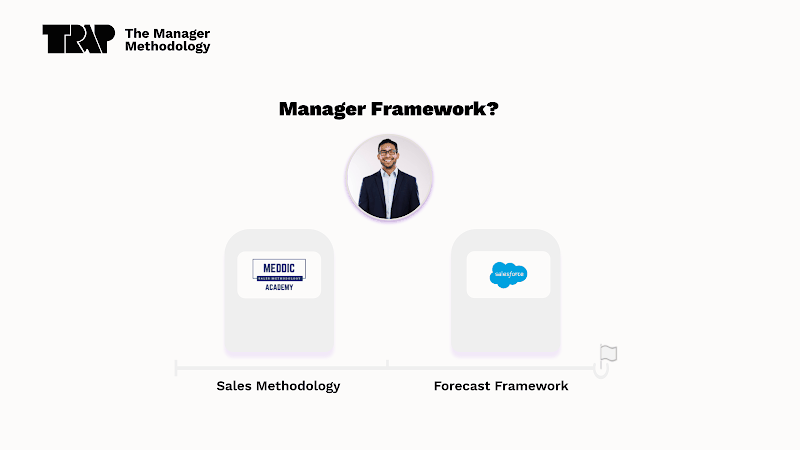
TRAP
Finally a Management Methodology Built for Sales Leaders!
Filling the void
The TRAP framework fills the void for organizations that need a way for sales managers to connect their sales methodology and forecasting frameworks into proactively getting ahead of risky sales pipeline.
Unlocking success
Empowering leaders to translate GTM strategy into actionable daily tactics for the field.
Prioritized Focus
The TRAP framework stitches together critical data points allowing sales managers a zoomed out and prioritized view of where to further inspect.
Objective Reality
The TRAP frameworks empowers organizations to benchmark defined thresholds for sales managers on key metrics to determine if the data they are looking at is a red or green light.
Avoiding Lost Revenue
Armed with the clarity of data thresholds, sales managers now know where to further investigate to get ahead of potential lost revenue.
TRAP Framework
-
How a TRAP Manager thinks:
Time is a measurement tool against past success and a way to identify level of interest. They use the timeline of deals won to measure against and identify where deals start slowing. Time is also used to identify level of interest, they know serious buyers working on priorities keep moving forward, if progress stalls that is an early warning sign of a problem.
Measured with:
- Opportunity Age
- Stage Duration
- Close Date
- Close Date & Stage
-
How a TRAP Manager thinks:
Past won deal context is used to identify anomalies which are risks in the deal.They use these elements as a check and balance to find anomalies, they know doing anything for the first time is a bigger risk than winning where you have many past successes.
Measured with:
- Pain Point
- ICP Profile
- Deal Amount
- Tech Stack
-
How a TRAP Manager thinks:
Prospect activity in the deal from key stakeholder(s) is used as a barometer of health. The focus is on how broad the engagement is/was, who the engagement was with (in terms of seniority and role in the decision), how long it has been since that engagement, the consistency of the response to outreach from rep and what was their organic outreach from the prospect.
Measured with:
- Last Contact with stakeholder(s)
- Last Meeting with the account
- Amount of Activity (# of touches w/ responses)
- Breadth of Activity (# of contacts)
-
How a TRAP Manager thinks:
All decisions today require multiple stakeholders to sign off on a purchase. Reviewing who is involved compared to winning deals helps to validate we are talking to the right roles. Gaps in this engagement with key roles( i.e. single-threaded engagements) or weak engagement (emails versus calls/meetings expand the risk in winning the deal.
Measured with:
- Champion
- Key Stakeholders
- Engagement
- Customer’s Words
Clarity & Performance
TRAP is a clear guide on how to measure the progress of each deal and determine its rightful place within your forecast segments. It's not just another tool; it's the key to unlocking a more streamlined approach to deal management. Say hello to a smoother, more intuitive way of doing things with TRAP by your side.
FAQs
-
While sales methodologies serve the purpose of deal qualification and gathering opportunity data, they primarily cater to sales reps. They offer a detailed, zoomed-in view of individual deals, akin to viewing a single puzzle piece. The TRAP framework, on the other hand, encourages a holistic perspective, prompting one to think like a business owner, considering the broader implications. It complements existing methodologies by providing a comprehensive understanding of potential outcomes and risks.
-
The TRAP framework isn't a replacement for your existing tools; rather, it enhances your decision-making process by fostering a strategic mindset towards potential revenue loss. While tools are indispensable for data management and analysis, they often lack the capacity to guide strategic thinking. Without a structured approach to interpret and anticipate outcomes, data may become overwhelming or even misleading. TRAP bridges this gap by providing a systematic method to evaluate and mitigate risks, empowering managers to make informed decisions aligned with broader business objectives.
-
Your managers are likely already performing aspects of the TRAP framework intuitively. However, formalizing and standardizing these practices across the team can yield significant benefits. By embracing TRAP, managers gain a structured approach to risk assessment and mitigation, enhancing their effectiveness in navigating complex business scenarios. Additionally, standardization promotes consistency and facilitates knowledge sharing, driving maturity development within the team. While individual managers may already possess elements of TRAP, its formal adoption ensures a unified, strategic approach towards maximizing revenue potential and minimizing risks.







